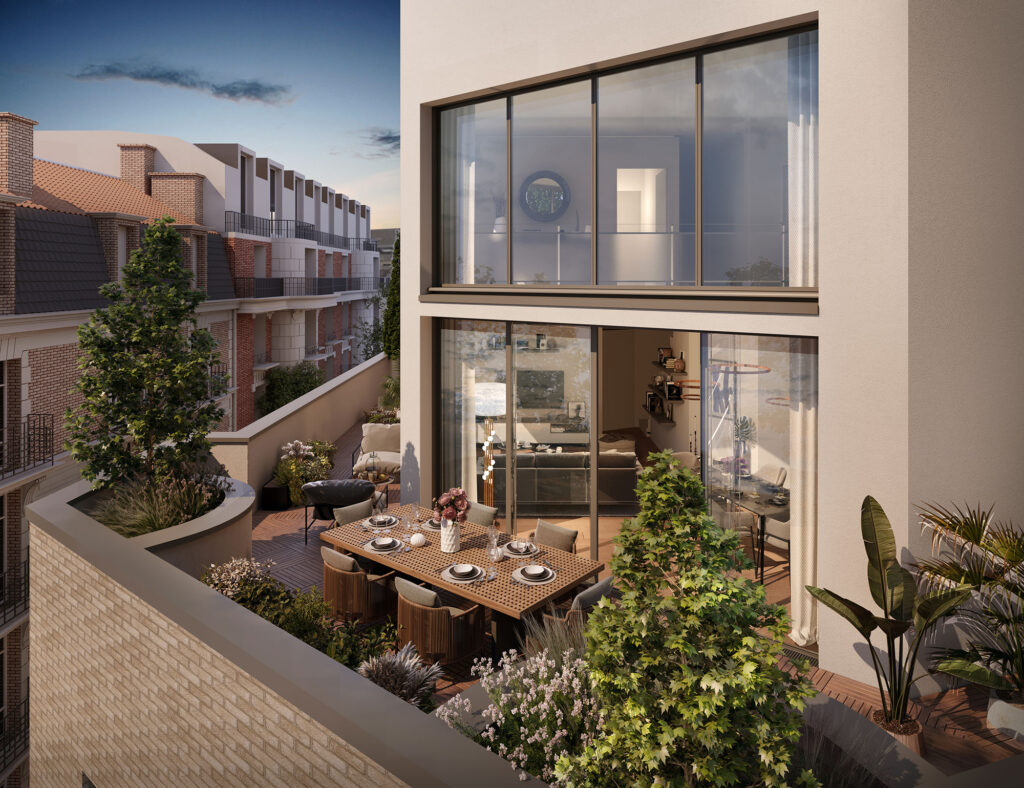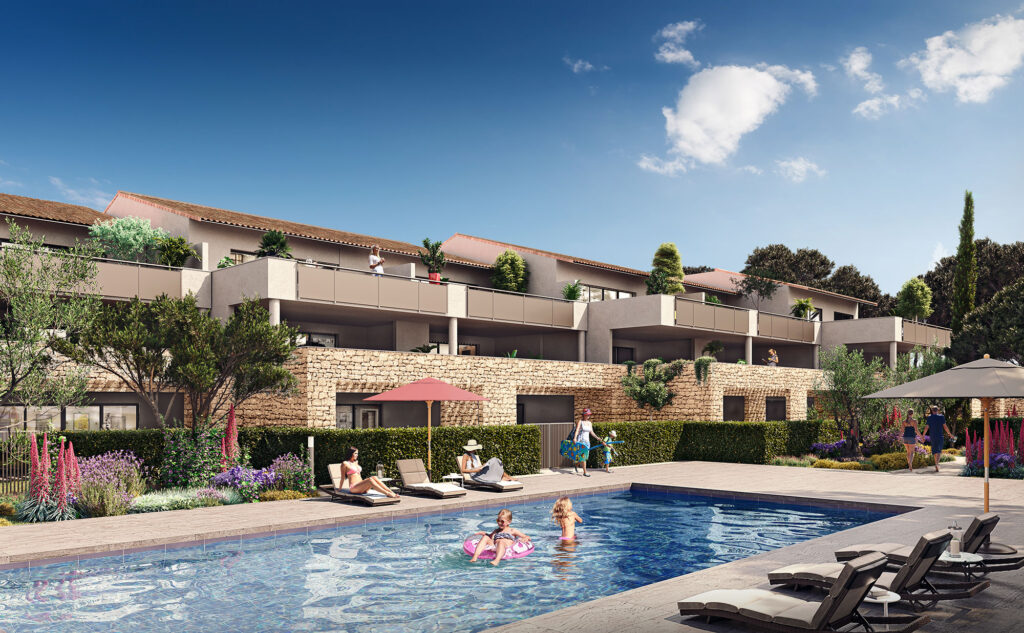Are you struggling to position yourself in the real estate development sector? Do your real estate projects generate little interest despite your best efforts? Creating an immersive marketing campaign may be just the solution you're looking for.
This approach involves using immersive technologies to guarantee a multi-sensory experience for your potential customers. Virtual tours, 3D animations and hyper-realistic renderings are real assets for real estate marketing.
Find out all you need to know about creating immersive marketing campaigns for real estate.
What forms of immersive marketing are used in real estate?

Immersive marketing is an advertising approach that uses innovative technologies to create an immersive experience for the audience.
An immersive real estate marketing campaign therefore refers to all actions aimed at promoting your brand and/or your real estate programs using immersive technologies such as 3D renderings, virtual reality or 360° videos.
Photorealistic 3D rendering
It's possible to integrate 3D rendering into your immersive marketing campaign. A 3D rendering is a visual presentation of a real estate project, obtained from 3D modeling.
It's a photorealistic image that shows various details of the property, such as materials, lighting and decorations. Its high level of realism provides an immersive experience for the public, plunging them directly into the heart of the property thanks to the illusion of depth.
Architectural 3D renderings are real marketing tools for real estate developers. They present the project realistically and aesthetically.
For example, with a 3D perspective, the prospect can feel the general atmosphere of the building thanks to the details of the lighting, which facilitates projection. But there are even more immersive technologies used in real estate marketing.
Virtual reality
Virtual reality is an immersive technology frequently used in immersive marketing campaigns for real estate. It is generally used in real estate visits through immersive virtual tours. The virtual tour offers an immersive experience to prospects because of :
- 360° rotation: view every corner of the room;
- The ability to move around: visit different rooms, floors or the surrounding landscape;
- The presence of details: doors, windows, furniture, decorations;
- Zoom in and out on specific elements.
All these features make virtual tours a real asset for immersive marketing. With just a few clicks, prospects can carry out a wide range of actions while feeling as though they're actually there.
The virtual tour is suitable for connected devices such as smartphones or PCs, and for VR headsets.
Augmented reality
Augmented reality is also beginning to be adopted in immersive marketing. It involves superimposing digital content onto a real environment to offer prospects an interactive experience.
Used in conjunction with virtual reality, it provides additional functionalities and enriches the user experience.
For example, this technology enablescertain information about the property tobe displayed in real time from an application. This could include the price, the property's technical specifications or the available lots in your real estate development.
Alongside augmented reality, mixed reality also offers an immersive, interactive experience. This interactive tool combines virtual and augmented reality, in which real and digital objects interact.
However, this technology is still not widely used in immersive real estate marketing.
3D Animation
Another immersive technology used in immersive marketing campaigns is 3D animation. This consists in immersively presenting a house, apartment or building thanks to its motion effect.
It is ideal for VEFA sales of properties that have not yet been built on.
In addition to the dynamic presentation of the different rooms in the house, you can add other options to enhance the immersive experience. For example, integrate a voice-over describing the premises or explaining the real estate project using powerful storytelling.
This guarantees a multi-sensory experience that stimulates the eyes and ears of potential buyers, creating a deep connection between them and the property.
Why create an immersive marketing campaign for your real estate projects?
Creating an immersive marketing campaign has many advantages for promoting your real estate projects.
Capturing attention
The primary function of marketing is to capture the attention of its target audience. In an increasingly saturated digital marketing world, it's essential to stand out from the crowd. Simple 2D visuals easily blend into the mass, whereas an immersive 3D rendering will naturally stand out from the crowd.
The high degree of precision and realism offered by immersive technologies arouses the public's curiosity. Potential buyers will be more inclined to click on your real estate ad to find out more about the project.
The more they immerse themselves in the property through the virtual tour, the greater the emotion they'll experience.
Building customer loyalty
The role of the immersive marketing campaign doesn't stop at attracting customers. It also serves to build customer loyalty by strengthening customer engagement.
The customer is not simply a spectator, but can interact with the environment by virtually walking around a room or zooming in on elements.
Some 3D tools, such as an orbital model, can sometimes incorporate a configurator. This enables customers to make certain modifications, such as removing a partition or moving a piece of furniture.
Offering an immersive, personalized experience in your real estate marketing campaign guarantees customer satisfaction.
Increase brand awareness
Beyond the commercial benefits, an immersive marketing campaign also increases your brand awareness. By creating an emotional connection with your target audience, they're more likely to remember your brand.
Not only does this boost customer confidence, it also encourages word-of-mouth. Indeed, the unique experience offered to customers encourages them to share their experience with others.
To achieve this, your marketing campaign must be consistent with your objectives and your target audience.
Boost sales
Finally, immersive marketing influences customers' purchasing decisions and behaviors. The ability to visualize a property in an immersive way facilitates customer projection and decision-making. Immersive 3D technologies increase yourconversion rate and sales.
An immersive real estate marketing campaign offers a real competitive advantage. It can ensure a good return on investment, provided it is properly implemented.
How do you create an effective immersive marketing campaign?

There are several elements to consider when creating an effective immersive marketing campaign.
Choice of immersive content and communication channels
As mentioned above, there are many forms of immersive technology. The choice depends on your objectives, whether you're promoting your brand or prospecting for real estate projects.
You can launch your immersive marketing campaign on :
- Your website: you can insert virtual tours, 3D plans, orbital models and any other 3D visuals so that prospects can access them directly.
- Your social networks: 360° videos and 3D images can be easily adapted to social platforms such as YouTube, Facebook, Instagram and LinkedIn.
However, don't forget the basics of successful marketing, such as site fluidity, relevant content, quality visuals and calls to action.
Test and optimization
Make sure that your immersive content performs well, i.e. that it's free from bugs and latency that can harm the customer experience.
3D graphic designers optimize immersive 3D tools using a variety of techniques, such as reducing the number of polygons, adjusting the complexity of a model or optimizing the overall file.
Next, you need to run tests to identify potential bugs and security holes in your immersive campaign.
User tests, performance tests and security tests carried out beforehand enable you to make modifications and adjustments before launching your immersive marketing campaign.
Respect for legal and ethical issues
The use of immersive marketing still comes up against certain ethical and legal challenges that need to be taken into consideration. From an ethical point of view, immersive marketing is sometimes criticized for influencing - not always in the right way - consumer behavior.
Your marketing content must respect users' autonomy, well-being and dignity. Your marketing campaign must provide clear and transparent information to users about the immersive experience and its potential effects.
On the legal side, there are also risks. Immersive marketing sometimes involves the use of personal data and intellectual property, which may be subject to regulation.
If you're based in Europe and collect personal data on your prospects and customers, you need to comply with the RGPD. Otherwise, you risk exposing yourself to severe penalties, which damage your brand image at the same time.
We create your immersive marketing tools








